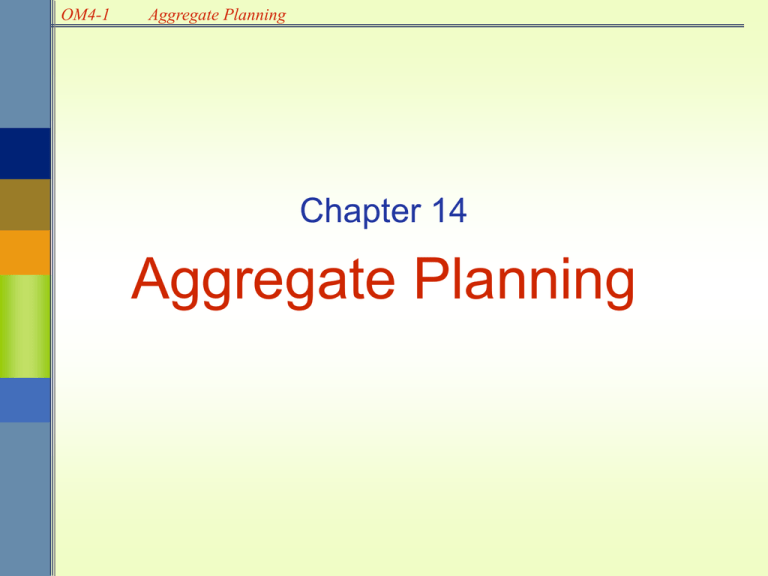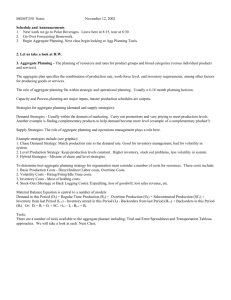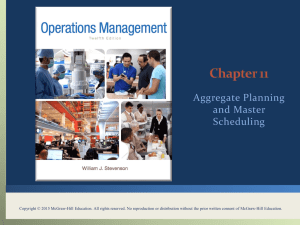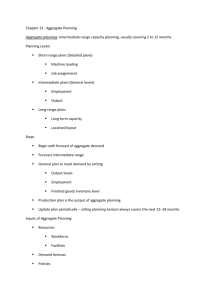Aggregate Planning
advertisement

OM4-1 Aggregate Planning Chapter 14 Aggregate Planning OM4-2 Aggregate Planning Planning Horizon Aggregate planning: Intermediate-range capacity planning, usually covering 2 to 12 months. Long range Short range Now Intermediate range 2 months 1 Year OM4-3 Aggregate Planning Overview of Planning Levels • Short-range plans (Detailed plans) – Machine loading – Job assignments • Intermediate plans (General levels) – Employment – Output • Long-range plans – Long term capacity – Location / layout OM4-4 Aggregate Planning Planning Sequence Corporate strategies and policies Economic, competitive, and political conditions Business Plan Aggregate demand forecasts Establishes production and capacity strategies Production plan Establishes production capacity Master schedule Establishes schedules for specific products OM4-5 Aggregate Planning Aggregate Planning Inputs • Resources – Workforce – Facilities • Demand forecast • Policy statements – Subcontracting – Overtime – Inventory levels – Back orders • Costs – Inventory carrying – Back orders – Hiring/firing – Overtime – Inventory changes – subcontracting OM4-6 Aggregate Planning Aggregate Planning Outputs • Total cost of a plan • Projected levels of inventory – Inventory – Output – Employment – Subcontracting – Backordering OM4-7 Aggregate Planning Demand Options • • • • Pricing Promotion Back orders New demand OM4-8 Aggregate Planning Capacity Options • • • • • Hire and layoff workers Overtime/slack time Part-time workers Inventories Subcontracting OM4-9 Aggregate Planning Aggregate Planning Strategies • Maintain a level workforce • Maintain a steady output rate • Match demand period by period • Use a combination of decision variables OM4-10 Aggregate Planning Basic Strategies • Level capacity: – Maintaining a steady rate of regular-time output while meeting variations in demand by a combination of options. • Chase demand: – Matching capacity to demand; the planned output for a period is the expected demand for that period. OM4-11 Aggregate Planning Techniques for Aggregate Planning • • • • • • Determine demand for each period Determine capacities for each period Identify policies that are pertinent Determine units costs Develop alternative plans and costs Select the best plan that satisfies objectives OM4-12 Aggregate Planning Cumulative Graph Cumulative output/demand Figure 14-3 1 Cumulative production Cumulative demand 2 3 4 5 6 7 8 9 10 OM4-13 Aggregate Planning Average Inventory Average Beginning Inventory + Ending Inventory = inventory 2 OM4-14 Aggregate Planning Aggregate Planning: Problem 1 The Sherman-Brown Chemical Company is about to finalize its aggregate capacity plan for next year. The company produces three paint products: latex interior, latex enamel, and latex stain, on a produce-to-stock basis. The production plant is located in Cleveland, Ohio, where there is an abundance of workers who perform the duties of material preparation, mixing, and canning; the principal operations of the production line. The latex carrier, pigments, cans, boxes, and other materials required to produce Sherman-Brown's products are also readily available from tried and proven suppliers in abundant quantities. The processing equipment in the production department is operated on only one shift because Sherman-Brown's management bought out a competitor last year, and so an excess of machine capacity is available. Similarly, ample warehouse space for holding finished-goods inventory is available. OM4-15 Aggregate Planning Aggregate Planning: Problem 1 (cont.) The capacity situation at Sherman-Brown is this: Because the only limiting factor in capacity planning is the size of the work force, the only production capacity issue to be resolved is determining the number of workers to be employed during each time period to support the sales forecasts of the three paint products. Two plans for providing production capacity are currently being considered by Sherman-Brown's plant manager: (1) level production and (2) matching capacity with demand. These two alternatives must be evaluated in terms of which plan results in the lowest total annual cost while considering three elements of cost: (1) cost of hiring workers from time period to time period over the entire year, (2) cost of laying off workers over the same period, (3) cost of carrying the finishedgoods inventory for the entire year. OM4-16 Aggregate Planning Aggregate Planning: Problem 1 (cont.) The pertinent data for this analysis are: working days per quarter: 65; labor standard per gallon for all types of paint: 2.311 worker-hours per gallon; working hours per shift: 8 hours per shift per worker; maximum machine capacity on one shift: 100,000 gallons per quarter for all types of paint; annual hiring cost per worker: $250; annual layoff cost per worker: $300; annual inventory carrying cost: $5 per gallon per year. Assume that the pattern of quarterly demand repeats from year to year and that the beginning inventory is zero. OM4-17 Aggregate Planning Aggregate Planning: Problem 1 (cont.) The key analyses that must be performed by Sherman-Brown in developing an aggregate capacity plan are: 1. Develop an aggregate demand forecast from the three individual product forecasts. 2. Compare the two alternatives for providing production capacity in the number of workers hired, the number of workers laid off, and the average finished-goods inventory levels for the entire year. 3. Develop an analysis of the two alternatives for providing production capacity in terms of their impact on worker employment levels and finished-goods inventories. 4. Select the capacity plan alternative with the lowest annual cost. OM4-18 Aggregate Planning Aggregate Planning: Problem 1 Demand (in gallons) Aggregate Quarter Latex Interior Latex Enamel Latex Stain Demand 1 30,000 2,500 7,500 40,000 2 25,000 20,000 12,500 57,500 3 27,500 20,000 7,500 55,000 4 35,000 10,000 7,500 52,500 Total Demand 205,000 OM4-19 Aggregate Planning Aggregate Planning: Problem 1 Solution Working Days per Quarter per Worker: 65 Number of Hours per day: 8 Labor Standard: 2.311 Number of workers = Output per Quarter * Labor Standard_________ Working Days per Quarter per Worker * Number of Hours per Day OM4-20 Aggregate Planning Aggregate Planning: Problem 1 Solution 1 2 3 4 5 8 9 10 11 12 Average Inventory Aggregate Planned Aggregate Inventory Average Addition Beginning Ending Demand Outputs Workers Plan Quarter (gall) (gall) Level 1 40,000 51,250 228 Production 2 57,500 51,250 228 or Required Subtract. per Annual Beginning Inventory Quarter Inventory (gall) (gall) (gall) 11,250 0 11,250 5,625 -6,250 11,250 5,000 8,125 (gall) 4,375 3 55,000 51,250 228 -3,750 5,000 1,250 3,125 4 52,500 51,250 228 -1,250 1,250 0 625 Average 51,250 OM4-21 Aggregate Planning Aggregate Planning: Problem 1 Solution 1 2 Aggregate 3 4 5 6 7 Aggregate Planned Demand Outputs Workers Workers Workers Plan Quarter (gall) (gall) Required Hired Laid-off Matching Demand 1 40,000 40,000 178 0 56 2 57,500 57,500 256 78 0 3 55,000 55,000 245 0 11 4 52,500 52,500 234 0 11 78 78 OM4-22 Aggregate Planning Aggregate Planning: Problem 1 Solution Carrying Cost: $5 per gallon per year Hiring Cost: $250 per worker Layoff Cost: $300 per worker OM4-23 Aggregate Planning Aggregate Planning: Problem 1 Solution 1 2 3 4 5 6 7 Total Total Annual Number Aggregate Of Workers Plan Hired Total Annual Annual Number Average Of Annual Workers Inventory Laid-off 8 (gallons) Annual Annual Annual Inventory Incremental Hiring Layoff Carrying Operating Cost Cost Cost Cost ($) ($) ($) ($) 21,875 21,875 Level Production 4,375 Matching Demand 78 78 19,500 23,400 42,900 OM4-24 Aggregate Planning Aggregate Planning: Problem 2 The Sherman-Brown Chemical Company has been considering keeping only enough workers employed on straight time per quarter to produce 40,000 gallons. Either subcontracting or overtime would be used to supply the difference between the straight-time production capacity of 40,000 gallons per quarter and the highly variable quarterly demand. Sherman-Brown will finish the materials and has a quote from a subcontractor for a price of $19.50 per gallon for each gallon supplied, and the subcontractor has guaranteed that it could supply up to 20,000 gallons a quarter. Sherman-Brown's labor union is willing to work as much overtime as necessary to avoid the use of the subcontractor. The cost of overtime pay is $9.50 per hour of overtime worked. Compute the overtime cost and the subcontracting cost per quarter for the two aggregate plans. OM4-25 Aggregate Planning Aggregate Planning: Problem 2 Solution Cost of Overtime Pay: $9.50 per hour of overtime Cost of Subcontracting: $19.50 per gallon Labor Standard: 2.311 worker hours per gallon OM4-26 Aggregate Planning Aggregate Planning: Problem 2 Solution 1 2 3 5 6 7 8 Gallons to be Straight Aggregate Aggregate Time Supplied by Overtime or Cost of Cost of Demand Production Subcontracting Overtime Subcontracting Plan Quarter (gall) (gall) (gall) ($) ($) Overtime 1 40,000 40,000 0 0 0 Versus 2 57,500 40,000 17,500 384203.8 341250 Subcontracting 3 55,000 40,000 15,000 329317.5 292500 4 52,500 40,000 12,500 274431.3 243750 Total Cost 987952.5 877500 OM4-27 Aggregate Planning Mathematical Techniques Linear programming: Methods for obtaining optimal solutions to problems involving allocation of scarce resources in terms of cost minimization. Linear decision rule: Optimizing technique that seeks to minimize combined costs, using a set of cost-approximating functions to obtain a single quadratic equation. OM4-28 Aggregate Planning Summary of Planning Techniques Technique Solution Characteristics Graphical/ charting Trial and error Linear programming Linear decision rule Optimizing Simulation Trial and error Intuitively appealing, easy to understand; solution not necessarily optimal. Computerized; linear assumptions not always valid. Complex, requires considerable effort to obtain pertinent cost information and to construct model; cost assumptions not always valid. Computerized models can be examined under a variety of conditions. Optimizing OM4-29 Aggregate Planning Aggregate Planning in Services • Services occur when they are rendered • Demand for service can be difficult to predict • Capacity availability can be difficult to predict • Labor flexibility can be an advantage in services OM4-30 Aggregate Planning Disaggregating • Master schedule: The result of disaggregating an aggregate plan; shows quantity and timing of specific end items for a scheduled horizon. • Rough-cut capacity planning: Approximate balancing of capacity and demand to test the feasibility of a master schedule. OM4-31 Aggregate Planning Master Scheduling Process Figure 14-5 Inputs Outputs Beginning inventory Forecast Customer orders Projected inventory Master Scheduling Master production schedule Uncommitted inventory OM4-32 Aggregate Planning Projected On-hand Inventory Figure 14-8 Beginning Inventory 64 Forecast Customer Orders (committed) Projected on-hand inventory Customer orders are larger than forecast in week 1 1 30 JUNE 2 3 30 30 4 30 5 40 33 20 10 4 2 31 1 -29 JULY 6 7 40 40 8 40 Forecast is larger than Customer orders in week 3 Forecast is larger than Customer orders in week 2 OM4-33 Aggregate Planning Time Fences in MPS Figure 14-12 Period 1 2 3 frozen 4 5 6 firm 7 8 9 full 10 11 open 12







